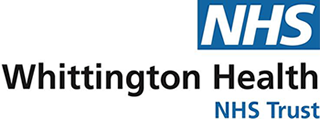Back and Neck Pain
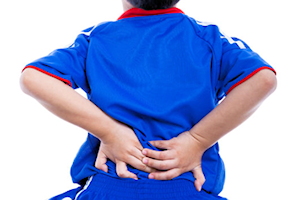 Back and neck pain are common issues in adults, but it is increasingly recognised
in children and young people. It can have a impact on a child’s daily life, affecting their ability to participate in school, sports,
and other activities.
Back and neck pain are common issues in adults, but it is increasingly recognised
in children and young people. It can have a impact on a child’s daily life, affecting their ability to participate in school, sports,
and other activities.
Causes of Back and Neck Pain in Children and Young People
- Postural Issues: Poor posture, often due to prolonged sitting in school, using computers or mobile devices, or carrying heavy backpacks, is a leading cause of back and neck pain. Slouching, leaning forward, or improper ergonomic setups can strain the muscles and ligaments in the spine.
- Sports Injuries: Active children and adolescents involved in sports may experience injuries leading to back or neck pain. Overuse injuries, improper techniques, or acute trauma (such as falls or collisions) can all contribute to pain in these areas.
- Growth Spurts: Rapid growth during puberty can sometimes lead to musculoskeletal imbalances, where muscles and bones grow at different rates, causing discomfort or pain, particularly in the back.
- Scoliosis and Other Spinal Conditions: Conditions like scoliosis (a curvature of the spine) or Scheuermann’s disease (a condition where the spine grows unevenly, leading to a hunched back) can cause chronic back pain in children.
- Stress and Psychosocial Factors: Stress, anxiety, and other psychological factors can manifest physically, including through back and neck pain. Children and adolescents experiencing high levels of stress may unconsciously adopt tense postures, leading to discomfort.
- Congenital or Developmental Issues: Some children may be born with or develop conditions that affect the spine, such as congenital vertebral anomalies or spina bifida, which can lead to back and neck pain.
Common back and neck pain symptoms in children and young people
- Generalised aching into the neck/lower back and/or mid back.
- Tightness in back and neck on movement.
- Pain worse with activity or prolonged activity or sustained positions.
- Slouched postures and pain increased with sitting up straight from a slouched posture.
- Pain irritated by prolonged sitting in hard chairs.
- Pain improved with application of heat.
- Pain improved with rest.
Prevention and Management Strategies
Preventing back and neck pain in children and young people is as important as treating it. Key strategies include:
- Encourage Regular Physical Activity: Keeping children active helps maintain a healthy weight, strengthen muscles, and improve flexibility, all of which support a healthy spine. Children aged 5-18 years should aim to be physically active for 60minutes each day.
- Promote Good Posture: Ensuring that children have properly adjusted desks, chairs, and screens at school and home can prevent poor posture-related pain.
- Safe Backpack Use: Backpacks should be appropriately sized, not overloaded, and worn on both shoulders to distribute weight evenly. For more information on choosing the correct backpack see the Association of Paediatric Chartered Physiotherapists leaflet: APCP: Choosing the right school bag
- Encourage Movement Breaks: Children should take regular breaks from sitting, especially when using computers or mobile devices, to stretch and move around. Consider reducing screen time in sustained positions including when gaming or studying on the bed.
- Sleep hygiene: Achieving good quality sleep improves your child’s physical health, but also their educational, social and emotional well-being. Ways to promote good sleep hygiene are exercising during the day, limiting caffeine intake e.g. fizzy drinks, no screen time 1 hour before bedtime, creating a bedtime routine. The recommended sleep time for children 6-12 years old is 9 to 12 hours and for teenagers 13 to 18 years old is 8 to 10 hours.
Clicking in Neck and Back
Often this is associated with having increased flexibility in the neck or in the back. Children’s joints who have increased
flexibility move more than usual and may experience ‘clicky’ joints which may click repeatedly but is usually harmless.
Being flexible is not necessarily a problem and keeping strong and physically active helps to strengthen the muscles around the joints
to keep them strong. Please enquire about our online webinars for Flexible Joints.
Neck Related Headaches (Cervicogenic headaches)
Children can experience chronic headaches associated with neck pain and restriction in range of motion of the neck. The main symptoms are pain usually on one side of the head and/or face and neck, same sided shoulder pain/ arm pain and reduced range of motion of the neck. This can be due to a dysfunction in how the muscles in the neck control the movement of the vertebra (bones) in the neck. Pain is usually made worse by neck movement or poor posture.
Management strategies:
- Promote Good Posture: Ensuring that children have properly adjusted desks, chairs, and screens at school and home.
- Encourage Movement Breaks: Children should take regular breaks from sitting, especially when using computers or mobile devices, to stretch and move around. Consider reducing screen time in sustained positions including when gaming or studying on the bed
- Neck range of motion exercises: These exercises aim to improve the movement of the neck from any loss of range of motion. See below neck exercises
- Strengthening the deep neck flexors: These exercises work to strengthen the deep muscles of the neck which improves the control of the movement of the neck. See below neck strengthening exercises.
When to seek professional help
Please see your GP if your child if you are worried about your child’s neck or back pain.
- New onset of back or neck pain in a child under 12
- Complaints of persistent or recurring pain in the back or neck despite trying self-help strategies listed on this page.
- Avoidance of certain activities, particularly those involving physical exertion.
- There is a noticeable change in posture.
- Difficulty moving the head, neck, or back.
- Signs of nerve involvement, such as numbness, tingling, or weakness in the arms or legs
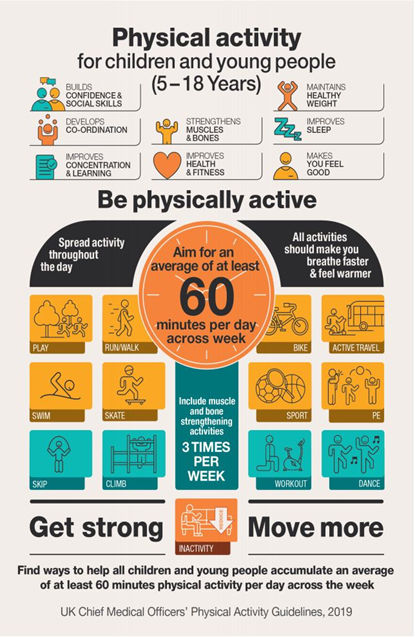
Exercises can also be very helpful to stretch tight muscles and strengthen weaker muscles around your neck and back and can alleviate and reduce pain.
Neck strengthening exercises
Deep neck flexors a)
- Lie on your back with your knees bent and your feet flat on the floor.
- Place a pillow or towel under your head and look up towards the ceiling.
- Gently nod your chin (chin tuck) without tensing your side neck muscles. Use the muscles, deep at the front of your throat instead
- This is a very subtle exercise and will take practice to tuck your chin in just enough, so you feel the back of your head a little heavy on the pillow but without the activity of your side neck muscles.
- These deep neck muscles are important to retrain to help headaches and neck issues from poor posture when studying or when gaming.
- Hold your chin downwards as advised and continue to breath in a controlled manner by expanding and contracting your lower ribcage.
- Hold for 10seconds and repeat 10 times
-500px.jpg)
Neck retraction on all fours
- Position yourself on all fours with your knees under your hips and your hands under your shoulders.
- Gently pull in your belly button in towards your spine, then gently draw your shoulder blades together.
- Keep your eyes looking between your hands and gently lift your head away from the floor, so your neck and back are in line.
- You are activating the correct neck muscles when you can still gently nod your head on your neck without your whole neck moving.
- Hold for 10 seconds and repeat 10 times
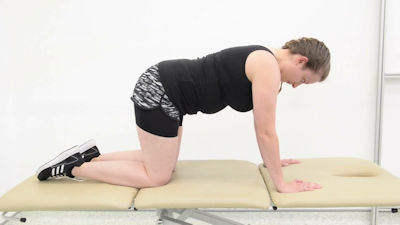
Back stretches
Kneeling back stretch
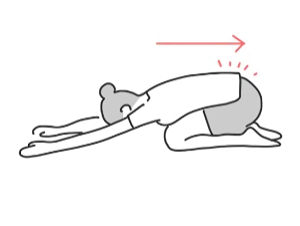
- Start on both hands and knees.
- Slowly sit back until your buttocks touches your heels.
- Then begin to walk your hands forwards until stretch felt in your back. .
- Hold this stretch for 3x30 seconds.
- Complete this stretch 3x every day.
Back extension stretch
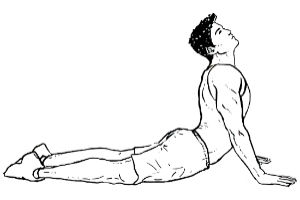
- Start with elbows bent and forearms and chest flat against the floor.
- Keeping pelvis against the floor throughout.
- Bring chest off the floor as far as possible whilst keeping forearms flat on floor. Hold for 30 seconds.
- Slowly bring chest further up whilst extending elbows to increase stretch. Keep pelvis on floor. Hold for 30 seconds.
Knee rolls
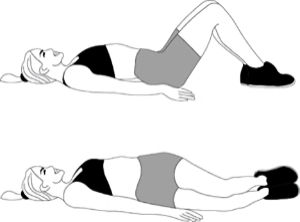
- Lie on your back with your knees bent and your feet flat on the floor.
- Extend your arms out to the sides and always keep your shoulders on the mat.
- Keeping knees together, drop them down to one side, rotating your torso.
- Return to the starting position and allow your knees to fall to the opposite side.
- Only drop your knees as far as you go comfortably.
- Hold stretch on each side for 3x20 seconds.
- Complete 3x daily.
Knees to chest stretch
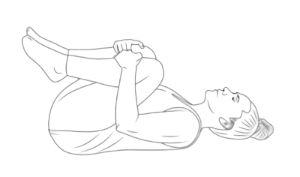
- Lie on your back
- Draw one foot up and then the other.
- Bring one knee in towards your chest and then the other, using your hands for and then the other, using your hands for assistance to curl yourself in to a ball.
Cat and Camel stretch
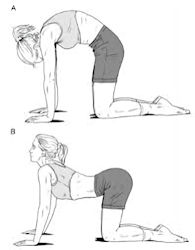
- Start on your hands and knees with your back in a neutral position.
- Arch your back, lifting your head up and pushing your tail bone out, making a dish with your spine.
- Hold this position for 10 seconds.
- Next, bend your back up by tucking your head and tail bone in and pulling your belly button in towards your spine, making a curve through your back.
- Hold this position for 10 seconds.
- Hold each position x6//3x daily.
Superman
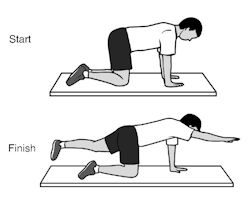
- Start on both hands and knees.
- Bring one leg up and straighten at the knee as far as possible whilst maintaining a level pelvis.
- Then bring the opposite arm up so that it is pointing straight forward.
- Maintain this position for 3x20 seconds on each side.
- Complete this exercise daily.
Pelvic tilts
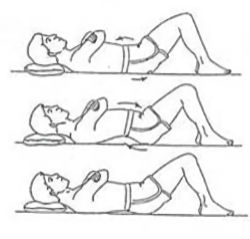
- Lie on your back with both legs bent and your feet flat on the floor.
- Keep a hips distance between both legs.
- Slowly tilt your pelvis by tightening your buttock and stomach muscles, flattening your back onto the floor.
- Your tail bone should roll off the floor..
- Relax, then tilt your pelvis in the other direction, arching your lower back.
Thread the needle
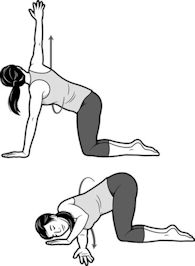
- Start on your hands and knees, with your hands under your shoulders and knees under your hips
- Take one hand off the floor and reach in and through between your other arm and your legs..
- Allow your body and head to follow, moving your shoulder down towards the floor as your hand reaches through.
- You should feel a stretch down your side, your shoulder blade and neck.
- Hold this position, and then return to the starting position.
- Reach your arm out to the other side, and then up towards the ceilig
- Follow the movement of your hand with your head, twisting in the other direction to look up towards the ceiling.
- Hold this position, and then repeat the sequence.
Neck range of motion
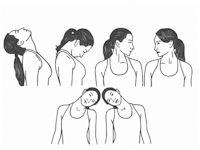
- Started in a seated position.
- Turn your head to look up to the ceiling, down to the floor, over each shoulder and bring your ear sideways down to your shoulder.
- Repeat each direction 5-10 times. 3x daily
Hip and Knee Stretches
Seated Hamstring Stretch
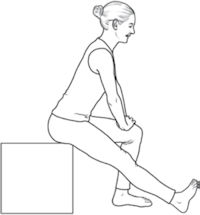
- Sit upright on the edge of a seat.
- Place the leg to be stretched out in front of you.
- Keep your knee, and your back straight.
- Point toes towards the sky.
- Lean forwards until you feel a stretch down the back of your thigh.
- Hold this position for 2x 30 seconds on each leg.
- Complete 3x daily
Quadriceps stretch
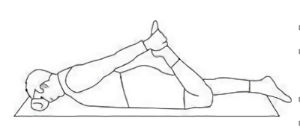
- Lie on your front with your legs together and your head resting on a pillow or your hand.
- Gently bend your knee until you feel a stretch in the front of your thigh, use your hand to assist the movement.
- Hold this position for 2 x 30 seconds on each leg.
- Complete 3x daily
Lunging Hip Flexor stretch
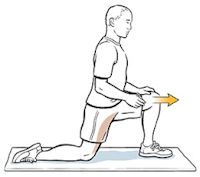
- Start in a kneeling position
- Place one foot on the floor out in front of you whilst staying on the knee of the other leg.
- Tuck your bottom in.
- Keep your back upright and chest out, push your hips forward by bending your front knee.
- Make sure that you keep your hips in position and do not let your lower back arch.
- Hold this position for 2 x 30 seconds on each leg
- Complete 3x daily
Core Strengthening Exercises
Planking

- Lie on your front with your toes on the floor.
- Place your forearms on the floor and push up, lifting your torso and legs.
- Hold a straight line from your shoulders to your feet for as long as you can, preventing the back from sagging.
- Keep your buttocks squeezed and your hips level.
- Tense your abdominal muscles.
Bridging
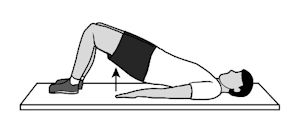
- Lie on your back with your knees bent and your feet flat on the floor.
- Tighten your buttock muscles and lift your hips up into the bridge position, creating a straight line between knees and shoulders.
- Make sure you keep your hips up and level throughout the movement. Engage core and buttocks muscles throughout.
Single leg bridge
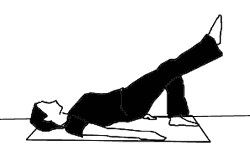
- Lie on your back with your legs hips width apart.
- Bend one leg, keeping your foot on the floor.
- Your knee and foot should be in aligned with hip.
- Tighten your abdominal and buttock muscles and lift your hips up off the floor, allowing your straight leg to lift with the movement.
- Your thighs should remain level.
- Hold 5seconds, repeat 10x3. 3-4 times a week
Hip abduction in side-lying
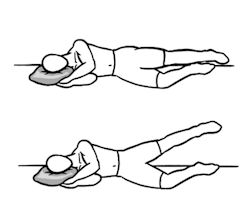
- Lie on your side, making sure there is a straight line from your head, through your trunk, down your legs to your toes.
- Straighten your legs and pull the toes up towards you.
- Raise the top leg straight up, then control the motion back down.
- Ensure your leg goes directly up, as though sliding up and down a wall.
- Control the movement as you lower your hips back to the floor and repeat with the other leg.
- Repeat 10x3. 3-4 times a week
what point will these exercises start to make a difference?
The above exercises can assist with managing symptoms at home. Most musculoskeletal conditions see improvement within 8-12 weeks.
Last updated10 Sep 2025

